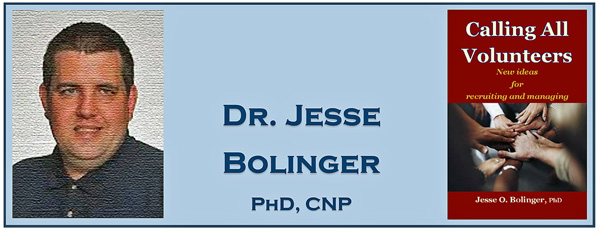Calling All Volunteers
$4.99
Calling All Volunteers offers value to the reader on many levels, from a better understanding of behavioral theory, including a suggested new hierarchy of needs and motivation, to explanations of generational cohorts focused on volunteer contributions and availability, and concluding with a suggested application process designed to enable a better fit between the volunteer and the position of service they might best fulfill in your organization.
For many nonprofit organizations, volunteers have served a vital purpose and have done so in roles ranging from administrative to facility management. The ideas and practices regarding the recruitment and retention of volunteers have remained consistent over the past several decades. However, with an aging population and the recognition that a large number of baby boomers are entering retirement years, new ways of recruiting volunteers are emerging. Dr. Jesse Bolinger is a strong believer in rural communities and in volunteerism. Through his research, new ideas on the recruitment and retention of volunteers have emerged. He presents a compelling case for an individual’s past work experience, educational background and mental health to play a role in the selection of volunteer positions and as a tool for retaining volunteers in areas that best suit these elements.
- File Size: 2648 KB
- Print Length: (114 pages (approximately, depending on display device)
- Publication Date: September 15, 2019
Description
Review:
Calling All Volunteers: New Research-based Insights for Volunteer Resource Managers, CEO’s and BoD’s.
By Dr. Jesse O. Bolinger, Ph.D., CNP
It was just 40 years ago that the first Nonprofit Organization Handbook was published (Connors, 1980). In 1980, there were 815,000 nonprofit organizations. Now there are more than 1.56 million charitable organizations. At the time, few would have agreed that there was such a professional area as “nonprofit management” or a “nonprofit executive.” Few colleges and universities offered courses in managing nonprofit organizations. Now, there are countless academic courses and majors that focus on producing the professional leaders and managers needed by hundreds of thousands of charities to fulfill their worthy public purposes, among them providing a myriad of human services that collectively we call “quality of life.”
Because nonprofit organizations provide the majority of human services in the United States, thus determining our overall quality of life, better management and leadership within these organizations directly contributes to an improved quality of life for millions of Americans.
In fact, the future of America’s quality of life depends upon the ability of our Third Sector charitable organizations not only to fulfill their public purposes, but to continue meeting the steadily increasing need for human services, even as the resources on which nonprofits depend to fulfill that need are evermore scarce.
Most charitable, nonprofit and charitable organizations – over 70% according to some sources – use volunteers in a wide variety of roles ranging from leadership and management, to hands-on support for those in need. Clearly, improving volunteer management within these organizations is critical to their ability to fulfill their public services missions, and for the Nonprofit Sector to meet the growing demand for human services.
It was only 25 years ago that the first Volunteer Management Handbook (Connors, 1995) was published. The VMH explained that creating and sustaining an effective volunteer management program within any nonprofit organization or agency is challenging. Ultimate organizational success depends on the knowledge and understanding by those leading and managing the program of important phases in the volunteer resource management process, including: planning, program analysis, position assessment and definitions, recruiting, orientation and training, supervision, recognition, and program evaluation.
Relying on canned solutions, or formulaic adoptions of other programs is risky, at best. Because every organization is unique in terms of its mission and purpose, location, and resources, program design needs to reflect not only current research findings, but that these findings are knowledgeably adapted from current and relevant research. The process of adapting research findings into practical management practice is called praxis. We need much more of it based on research focused on improved management practice and outcomes for nonprofit organizations.
A new e-Publication and softbound work by Dr. Jesse O. Bolinger, Ph.D., CNP, represents an important new example of the type of praxis needed if the nonprofit sector is to be successful in maintaining its contributions to our national quality of life.
Calling All Volunteers is a valuable new tool based on validated research that offers important insights into the vital process of using qualified volunteers to help their organizations fulfill their worthy public purposes, especially to better reach people with special needs. Dr. Bolinger’s research identified the extent to which retired seniors past work experiences and education have an impact on how and whether they are selected as volunteers.
As Dr. Bolinger explains, “considering people’s past work experiences, educational backgrounds, mental health, and reasons for wanting to volunteer makes a deeper understanding possible by drawing on their specific transferable and soft skills, which in turn, leads to more rewarding volunteer positions. Successful volunteers will not only increase the quality of work completed but will additionally add to the overall standard of the organization’s environment. This environment, then, will enhance programs with a potentially higher rate of goal achievement.”
The importance of incorporating validated theory, corroborated research, and practical application was stressed earlier in this review. Volunteers do so for a reason, a reason based on motivation. Bolinger assesses and compares Maslow’s hierarchy of needs, a foundation of motivation theory, and the Theory of Planned Behavior to establish a rationale for his own important contribution to volunteer management theory and practice: he suggests an expanded pyramid of needs, based on Maslow’s hierarchy, but more accurately reflecting the wide variety of life experiences represented by potential volunteers. Further, he urges readers to consider the theory behind the hierarchy and to visualize what their individual pyramid of needs might look like, and how this personal pyramid might best fit their needs for self-actualization.
Another section in this insightful work is the author’s discussion and review of generational traits and how they influence and affect volunteerism and volunteer resource management. Such insights are important to volunteer program managers faced with the challenges of constructing role descriptions, orientation and training programs, and in choosing those best practices most appropriate for their organization. Importantly, the author emphasizes the resource represented in the generational cohort of older volunteers.
The Mature/Silent Generation and the Baby Boomer Generation represent a growing reservoir of talent and experience that constitute a challenge in some respects to volunteer program managers, but offer important and unique benefits in service and contributions to volunteer programs. Bolinger cautions against the dangers of ageism, and argues strongly in favor of the enormous value senior volunteers bring to volunteer programs.
Generation Alpha, born between 2011 and 2025, promises to be the most technologically advanced and literate generation to date. His discussion of the interesting mix between technological advancement and socialization in this generation and their impact on volunteerism bring important insights for all volunteers and volunteer resource managers. His conclusions, based on his research, suggest special opportunities as well as special challenges in designing and creating volunteer programs that best utilize the multifaceted talents of this new generation.
Calling All Volunteers concludes by providing suggested applications for volunteers that more meaningfully and accurately gather insights from that applicant regarding their experience and interests. These new data will help volunteer managers create a better fit between volunteer and the position they may be offered within the organization.
Calling All Volunteers offers value to the reader on many levels, from a better understanding of behavioral theory, including a suggested new hierarchy of needs and motivation, to explanations of generational cohorts focused on volunteer contributions and availability, and concluding with a suggested application process designed to enable a better fit between the volunteer and the position of service they might best fulfill in your organization.
Tracy D. Connors, Ph.D.
Bibliography
Connors, T. D. (1980). The nonprofit organization handbook. New York: McGraw-Hill.
Connors, T. D. (1993). The nonprofit management handbook. New York, NY: John Wiley.
Connors, T. D. (1995). The volunteer management handbook. New York: John Wiley & Sons. Retrieved from http://www.wiley.com/WileyCDA/WileyTitle/productCd-0471371424.html
Connors, T. D. (1997). The nonprofit handbook: Management (2nd ed.). New York, NY: John Wiley & Sons.
Connors, T. D. (2001). The nonprofit handbook: Management (3rd ed.). New York, NY: John Wiley.
Connors, T. D. (2011). Volunteer management & leadership handbook (2nd ed.). Hoboken, NJ: John Wiley & Sons.





